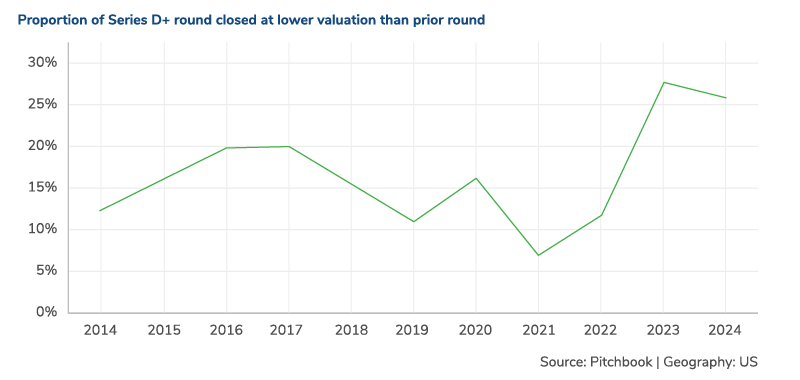Changes in the market environment, increasing complexity of securities, and heightened scrutiny of valuations are adding complications to fund managers’ valuation processes. Finding the right balance between greater transparency and efficiency is now paramount. While the use of automated models may result in improved efficiency, relying solely on technology-driven results poses risks from a regulatory and audit perspective.
Background: Changes in the PE/VC Landscape
In a recent article, we mentioned that scrutiny by stakeholders (regulators, auditors, investors) had sharpened dramatically as a result of (i) the changes in the market landscape, (ii) the rise in the number and value of illiquid securities held by funds, and (iii) the increasing complexity of securities. We concluded that estimating and supporting fair value is more challenging now, requiring experienced judgment and additional supporting documentation.
LP investors have recently been struggling with a lack of distributions; the limited number of transactions and delayed exits also results in a lack of recent data points to which a valuation analysis can be calibrated. Further, approximately 30% of VC-backed transactions during 2024 occurred at flat or down rounds (per Pitchbook), which is something we have not seen in over a decade. Moreover, we believe this number may be conservative given (i) the more prevalent use of SAFEs (Simple Agreements for Future Equity) and convertible notes (as the dilutive component may not be always evident), as well as (ii) the fact that a flat round may implicitly lower the value of previously issued securities if liquidation preferences (or other security features) differ from those securities.

Together with a significant increase in AI-related transactions (about 30% of U.S. deals were in AI companies), another trend we have observed lately is the use of more complex terms, including increasing liquidation preferences or minimum returns, and changing ownership claims over time, adding complexity to the valuation process.
Against this backdrop, investors are demanding greater transparency and valuation governance. In particular:
- Process-oriented questions are now a focus for investors and regulators.
- Independence—via the use of valuation experts—in valuations is viewed as a best practice.
- Fair value can help LPs in making appropriate asset allocation decisions.
It is therefore crucial to have a robust valuation process that follows the industry’s best practices and complies with the applicable reporting standards. Likewise, developing a thorough understanding of how values change over time is a critical component of the valuation process. In this regard, a “value bridge analysis” can be an invaluable tool to monitor changes in the value drivers of portfolio companies.
Achieving Balance between Greater Transparency and Efficiency: Considerations on Automated Models and Reliance on Latest Round of Financing
Alternative asset managers are increasingly adopting valuation software tools to enhance efficiency in managing data flow, automating repetitive calculations and standardizing valuation processes. These tools provide consistent methodologies, integrate diverse data sources, and make valuations more accessible, even to users with limited financial expertise. However, current software tools often lack the flexibility and judgment required to capture the nuances of valuation analyses, such as changing market sentiment, company performance, and unique investment characteristics.
Automated models or software tools typically rely heavily on data and treat comparability as a fixed relationship, which may overlook material changes in a company’s development or market conditions. Additionally, as stand-alone solutions, they may fail to meet regulatory and audit standards, including compliance with International Valuation Standards. While software can increase efficiency, regulatory and accounting guidance highlights that expert judgment remains essential to ensure valuations are both supportable and auditable, mitigating regulatory risks.
Similarly, reliance on the cost or value indicated by the latest funding round is increasingly viewed as a potential valuation issue because of the current limits in transaction availability. Additionally, with shifting economic conditions, value can materially change between funding events.
Automated Models–Pros and Cons
Pros | Cons |
|
|
Key Challenges (and Potential Remedies) When Valuing Portfolio Companies
Below is a summary of the more prevalent challenges faced by fund managers when it comes to measuring fair value.
1. Lack of Recent Calibration Data Points
The Calibrated Market Approach (CMA) can be a powerful ally. The CMA adjusts the latest calibrated multiple with changes in the market, the performance and outlook of the portfolio company, and the level of growth achieved since the latest calibration date.
2. Gap Between GAAP and Deal Teams
Often, CFOs “complain” about the disparity in values (deal team vs. what can be supported from a fair value perspective). Valuation experts can help bridge the gap by attending Valuation Committees and Board meetings.
3. How to Value Large Portfolios Efficiently
While the use of technology can help automate certain aspects of the analysis, it cannot replace the judgment that complex valuation analyses require. Relying on purely technology-driven results poses risks from a regulatory and audit perspective.
4. Liquidation Preferences in a Down Market and Impact of “Synthetic” Down Rounds
Assessing the impact of liquidation preferences in a down-market is critical (liquidation preferences don’t matter…until they matter). Further, a flat round may lower the value of previously issued securities if liquidation preferences (or other terms) differ (“synthetic” down round).
5. More Prevalent Use of SAFEs and Convertible Notes, as well as More Complex Terms (e.g., Increasing Liquidation Preferences, Minimum Multiple on Investment Capital)
Generally, backsolving and utilizing both the Option Pricing Model (OPM) and the fully diluted approach are necessary to accurately consider all the nuances. However, OPM often overstates the difference in value between senior and junior liquidation preferences due to the "sandwich” problem” (i.e., the liquidation preference for the junior preferred class is "sandwiched" between the senior preferred and the common stock). In situations like this, adjustments to the OPM are required. In addition, using scenario analysis may be necessary on certain instances (e.g., when valuing SAFES).
6. Data Availability (Information Rights), Quality of Data and Subjectivity in Assumptions (e.g., exit)
In addition, for early-stage companies, financials may be nonexistent or not meaningful. In situation like this, a “Milestone analysis” (which is similar to the CMA, but does not require financials) may be utilized.
7. Lack of Truly Comparable Companies
With the specialization of disruptive business models, finding good comparable companies is challenging. Further, public comps are typically at a later stage of development. Again, the CMA can be a helpful tool to overcome these obstacles.
8. How to Incorporate Changes in Market Conditions
When using the CMA, a correlation factor to the market movement may be applied based on the comparability of the portfolio company with the comparable companies.
9. How to Quantify the Impact of Growth on the Selected Multiple
When using the CMA, the latest calibrated multiple should be adjusted with a compression factor, which can be quantified based on the growth of the metric (often revenue) and the underlying rate of return.
10. How to Quantify the Impact of Changes in the Performance/Outlook
When using the CMA, the latest calibrated multiple should be adjusted with a performance adjustment factor.
11. What are best Practices for Supporting and Documenting a Valuation?
Adhering to varying regulations and standards can complicate the valuation process and create additional layers of scrutiny. Valuation experts can help by reviewing the fund’s valuation policies and ensuring best practices are followed.
12. Time and Resource Constraints
Valuation experts can help enhance the valuation process, thus reducing strain on internal resources and potentially simplifying the audit process.
Concluding Thoughts
As valuations face increased scrutiny, achieving the right balance between demands for transparency, enhanced documentation, and efficiency becomes crucial. While automated models can boost efficiency, relying solely on technology carries inherent regulatory and audit risks. By integrating technology with a best-in-class valuation process, these risks can be effectively mitigated.
How Kroll’s Portfolio Valuation Advisory Group May Assist
Kroll is a market leader in providing illiquid portfolio pricing valuation services to the alternative investment community, specifically for securities and positions for which there are no “active market” quotations available. We have authored or contributed to the leading regulatory and industry guidance related to fair value matters. Technical excellence and thought leadership are at the core of what we do. Our approach to valuation blends technology with experience-based judgment.
Kroll brings extensive and unparalleled industry-specific experience through years of working with some of the world’s foremost investors in alternative assets. We assist our clients through the valuation challenges of a single investment or an entire portfolio of investments, and we are flexible in working with our clients to do everything from providing a valuation opinion to designing and executing a process on behalf of our client. Further, we advise on valuation policy, including performing independent “diagnostic” assessments of a client’s existing valuation policy and assisting in the development and implementation of valuation “best practices.”
Lastly, we interact with audit teams, valuation committees, boards of directors, and investors on a regular basis. We understand their expectations and we can assist by participating in meetings and preparing support materials, including detailed responses to questions from stakeholders, including auditors.
Stay Ahead with Kroll
Valuation Services
When companies require an objective and independent assessment of value, they look to Kroll.
Alternative Asset Advisory
Heightened regulatory concerns and vigilance, together with increased investor scrutiny, have led to increased demand for independent expert advice.
Portfolio Valuation
Kroll specializes in assisting clients with the valuation of alternative investments, specifically securities and positions for which there are no "active market" quotations.



